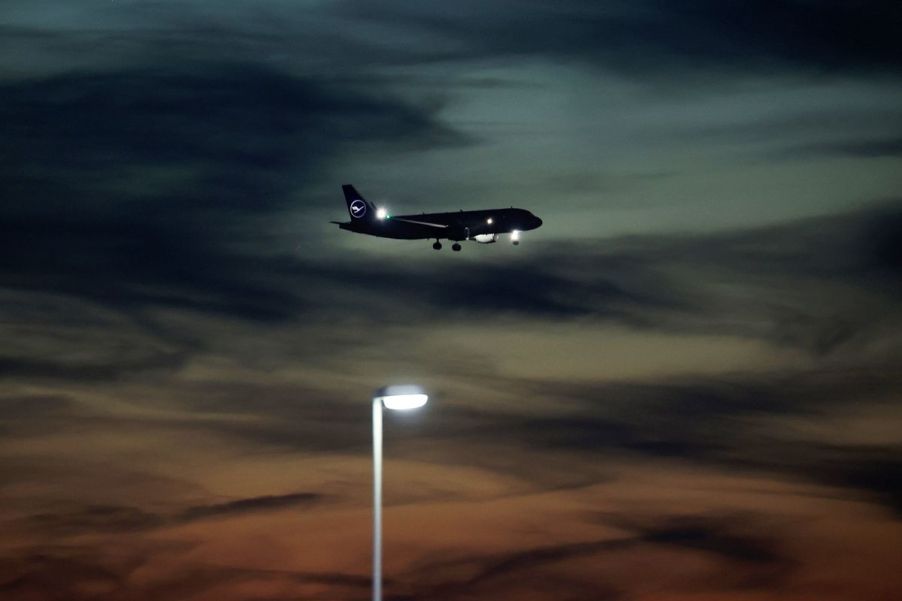
Why Are Airplane Wing Lights Different Colors?
Anyone looking at the sky between dusk and dawn will know green and red dots seen on any aircraft wafting through the sky. Although it’s common knowledge that airplanes must bear these essential illuminations, many outside the flying community may not know what they mean precisely.
People on the ground may delight in understanding the required airplane lights. After this dive into the different types of lighting on airplanes, the next time you view a night-time flyer, you’ll know exactly what direction they are heading.
Why are airplane wing lights red and green?

Whether solid or flashing, red or green, or operating at different points during a flight, external lights on airplane wings provide the pilot better sight during takeoff and landing, make the aircraft visible to other pilots and air traffic controllers, and provide illumination for other various purposes.
Although many lights are required by the Federal Aviation Administration (FAA), some are voluntary. The FAA‘s Aeronautical Information Manual (AIM) details lighting mandates in section 4-3-23.
What is port side on an airplane?

When ships were the primary method of travel and transport, green, red, and white navigation lights were added to specific positions on the vessel to mitigate collisions. As air travel progressed, the same lights were applied to aircraft in the flowing positions:
- Green: right (starboard) wingtip
- Red: left (port) wingtip
- White: aircraft tail, sometimes on wingtips oriented backward
These lights allow pilots and plane watchers alike to know the position and direction of the craft.
Do all airplanes have the same lights?
Beacon lights, better known as anti-collision lights, are located on the top of the aircraft in smaller planes and on the bottom of larger airliners, too. Although the lights don’t rotate as they did in maritime days of old, they are still flashing red lights that are turned on as soon as the engines are started and remain on until the planes are powered down.
It wasn’t until 1996 when the FAA mandated anti-collision lights on all airplanes built after March of that year. Yet, there’s an additional type of anti-collision light, the strobe light. These flashing white lights on the wingtips can be seen either flashing on and off in a regular pattern or pulsing in rapid bursts.
While the red anti-collision lights must be turned on before the plane taxis around the tarmac, the white anti-collision lights are only used during takeoff, landing, and routine flight as they are too bright for use on the ground, Pilot Institute states.
Illuminating the tarmac at night

The most powerful of an aircraft’s lights are the landing lights. These are located on the wings, nose, or under the plane’s fuselage and are positioned downward to illuminate the runway.
Modern aircraft boast auxiliary systems that pulse the starboard and port side lights in an alternating fashion to increase visibility, known as an Alternating Landing Light System (ALLS).
If a craft isn’t equipped with an ALLS, they may use another form of lighting to increase visibility. Located on the nose gear strut and the wings, taxi lights illuminate the tarmac in front of the plane so pilots can see which runway they need to be on and what else is around them. Yet, these types of lights can be seen in different configurations.
Taxi lights are often integrated with landing lights. Some pilots, however, fly craft where the taxi lights are the landing lights, just placed on a dimmer setting.
Since the taxi lights only light up what is in front of the airplane, other lights illuminate the sides of the plane on the tarmac. Runway turnoff lights are less bright than the landing lights and are positioned on both sides of the aircraft’s nose strut to assist in tight turns in tarmac traffic. Wing inspection lights are mounted on the fuselage, pointing backward toward the wings, and used to aid ground and flight crews in detecting ice formation on the wings.
Various purpose airplane lights
The above aircraft lighting is used ubiquitously, but more specialized planes tailor their lighting to their purpose and missions. Whether it be military, search and rescue, or corporate, appropriate lighting is used for all.
Some military and law enforcement aircraft utilize searchlights to illuminate objects on the ground during patrols or rescue flights. Formation lights are used primarily by military craft, but they are only visible on the infrared spectrum by pilots with night vision gear.
Civilian craft also have their own specialized purpose lighting. Generally called logo lights, these are mounted on the horizontal stabilizer of an aircraft and point upward toward the vertical stabilizer, illuminating the corporate plane or airliner’s logo. There are no legal requirements for logo lighting, and they were introduced solely as a marketing scheme for aircraft manufacturers and airline companies.


